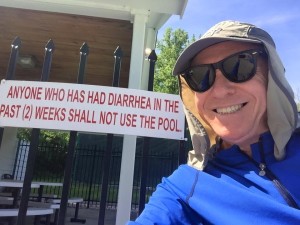I miss the hot tub we had in Kansas.
Yet in the U.S., thousands of public pools, hot tubs are closed each year due to serious violations.
 The U.S. Centers for Disease Control and Prevention reports that inspections of public pools and other aquatic venues enforce standards that can prevent illness, drowning, and pool-chemical–associated injuries such as poisoning or burns.
The U.S. Centers for Disease Control and Prevention reports that inspections of public pools and other aquatic venues enforce standards that can prevent illness, drowning, and pool-chemical–associated injuries such as poisoning or burns.
“No one should get sick or hurt when visiting a public pool, hot tub, or water playground,” said Beth Bell, M.D., M.P.H., director of CDC’s National Center for Emerging and Zoonotic Infectious Diseases. “That’s why public health and aquatics professionals work together to improve the operation and maintenance of these public places so people will be healthy and safe when they swim.”
Inspection data were collected in 2013 in the five states with the most public pools and hot tubs: Arizona, California, Florida, New York and Texas. Researchers reviewed data on 84,187 routine inspections of 48,632 public aquatic venues, including pools, hot tubs, water playgrounds and other places where people swim in treated water.
Among the key findings:
Most inspections of public aquatic venues (almost 80 percent) identified at least one violation.
1 in 8 inspections resulted in immediate closure because of serious health and safety violations.
1 in 5 kiddie/wading pools were closed—the highest proportion of closures among all inspected venues.
The most common violations reported were related to improper pH (15 percent), safety equipment (13 percent), and disinfectant concentration (12 percent).
“Environmental health practitioners, or public health inspectors, play a very important role in protecting public health. However, almost one third of local health departments do not regulate, inspect, or license public pools, hot tubs, and water playgrounds,” said Michele Hlavsa, R.N., M.P.H., chief of CDC’s Healthy Swimming Program. “We should all check for inspection results online or on site before using public pools, hot tubs, or water playgrounds and do our own inspection before getting into the water.”
When visiting public or private pools, swimmers and parents of young swimmers can complete their own inspection using a short and easy checklist that will identify some of the most common health and safety problems:
Use a test strip (available at most superstores or pool-supply stores) to determine if the pH and free chlorine or bromine concentration are correct. CDC recommends:
 Free chlorine concentration of at least 1 ppm in pools and at least 3 ppm in hot tubs/spas.
Free chlorine concentration of at least 1 ppm in pools and at least 3 ppm in hot tubs/spas.
Free bromine concentration of at least 3 ppm in pools and at least 4 ppm in hot tubs/spas.
pH of 7.2–7.8.
Make sure the drain at the bottom of the deep end is visible. Clear water allows lifeguards and other swimmers to see swimmers underwater who might need help.
Check that drain covers appear to be secured and in good repair. Swimmers can get trapped underwater by a loose or broken drain cover.
Confirm that a lifeguard is on duty at public venues. If not, check whether safety equipment like a rescue ring with rope or pole is available.
If you find problems, do not get into the water and tell the person in charge so the problems can be fixed. For more information and other healthy and safe swimming steps, visit www.cdc.gov/healthywater/swimming.
Before CDC-led development of the Model Aquatic Health Code, there were no national standards for the design, construction, operation, and maintenance practices to prevent illness and injury at public treated recreational water venues. Now, local and state authorities can voluntarily adopt these science- and best practices–based guidelines to make swimming and other activities at public pools and other aquatic venues healthier and safer. The second edition of the code will be released during the 2016 swim season. For more information about the Model Aquatic Health Code, visitwww.cdc.gov/mahc.
 Problem/Condition: Aquatic facility–associated illness and injury in the United States include disease outbreaks of infectious or chemical etiology, drowning, and pool chemical–associated health events (e.g., respiratory distress or burns). These conditions affect persons of all ages, particularly young children, and can lead to disability or even death. A total of 650 aquatic facility–associated outbreaks have been reported to CDC for 1978–2012. During 1999–2010, drownings resulted in approximately 4,000 deaths each year in the United States. Drowning is the leading cause of injury deaths in children aged 1–4 years, and approximately half of fatal drownings in this age group occur in swimming pools. During 2003–2012, pool chemical–associated health events resulted in an estimated 3,000–5,000 visits to U.S. emergency departments each year, and approximately half of the patients were aged <18 years. In August 2014, CDC released the Model Aquatic Health Code (MAHC), national guidance that can be adopted voluntarily by state and local jurisdictions to minimize the risk for illness and injury at public aquatic facilities.
Problem/Condition: Aquatic facility–associated illness and injury in the United States include disease outbreaks of infectious or chemical etiology, drowning, and pool chemical–associated health events (e.g., respiratory distress or burns). These conditions affect persons of all ages, particularly young children, and can lead to disability or even death. A total of 650 aquatic facility–associated outbreaks have been reported to CDC for 1978–2012. During 1999–2010, drownings resulted in approximately 4,000 deaths each year in the United States. Drowning is the leading cause of injury deaths in children aged 1–4 years, and approximately half of fatal drownings in this age group occur in swimming pools. During 2003–2012, pool chemical–associated health events resulted in an estimated 3,000–5,000 visits to U.S. emergency departments each year, and approximately half of the patients were aged <18 years. In August 2014, CDC released the Model Aquatic Health Code (MAHC), national guidance that can be adopted voluntarily by state and local jurisdictions to minimize the risk for illness and injury at public aquatic facilities.
Reporting Period Covered: 2013.
Description of System: The Network for Aquatic Facility Inspection Surveillance (NAFIS) was established by CDC in 2013. NAFIS receives aquatic facility inspection data collected by environmental health practitioners when assessing the operation and maintenance of public aquatic facilities. This report presents inspection data that were reported by 16 public health agencies in five states (Arizona, California, Florida, New York, and Texas) and focuses on 15 MAHC elements deemed critical to minimizing the risk for illness and injury associated with aquatic facilities (e.g., disinfection to prevent transmission of infectious pathogens, safety equipment to rescue distressed bathers, and pool chemical safety). Although these data (the first and most recent that are available) are not nationally representative, 15.7% of the estimated 309,000 U.S. public aquatic venues are located in the 16 reporting jurisdictions.
Results: During 2013, environmental health practitioners in the 16 reporting NAFIS jurisdictions conducted 84,187 routine inspections of 48,632 public aquatic venues. Of the 84,187 routine inspection records for individual aquatic venues, 78.5% (66,098) included data on immediate closure; 12.3% (8,118) of routine inspections resulted in immediate closure because of at least one identified violation that represented a serious threat to public health. Disinfectant concentration violations were identified during 11.9% (7,662/64,580) of routine inspections, representing risk for aquatic facility–associated outbreaks of infectious etiology. Safety equipment violations were identified during 12.7% (7,845/61,648) of routine inspections, representing risk for drowning. Pool chemical safety violations were identified during 4.6% (471/10,264) of routine inspections, representing risk for pool chemical–associated health events.
Interpretation: Routine inspections frequently resulted in immediate closure and identified violations of inspection items corresponding to 15 MAHC elements critical to protecting public health, highlighting the need to improve operation and maintenance of U.S. public aquatic facilities. These findings also underscore the public health function that code enforcement, conducted by environmental health practitioners, has in preventing illness and injury at public aquatic facilities.
Public Health Action: Findings from the routine analyses of aquatic facility inspection data can inform program planning, implementation, and evaluation. At the state and local level, these inspection data can be used to identify aquatic facilities and venues in need of more frequent inspections and to select topics to cover in training for aquatic facility operators. At the national level, these data can be used to evaluate whether the adoption of MAHC elements minimizes the risk for aquatic facility–associated illness and injury. These findings also can be used to prioritize revisions or updates to the MAHC. To optimize the collection and analysis of aquatic facility inspection data and thus application of findings, environmental health practitioners and epidemiologists need to collaborate extensively to identify public aquatic facility code elements deemed critical to protecting public health and determine the best way to assess and document compliance during inspections.
Immediate Closures and Violations Identified During Routine Inspections of Public Aquatic Facilities — Network for Aquatic Facility Inspection Surveillance, Five States, 2013
Surveillance Summaries / May 20, 2016 / 65(5);1–26
Michele C. Hlavsa, MPH; Taryn R. Gerth, MPH; Sarah A. Collier, MPH; Elizabeth L. Dunbar, MPH; Gouthami Rao, MPH; Gregory Epperson; Becky Bramlett; David F. Ludwig, MPH; Diana Gomez, MPH; Monty M. Stansbury; Freeman Miller; Jeffrey Warren; Jim Nichol; Harry Bowman; Bao-An Huynh, MPH; Kara M. Loewe; Bob Vincent; Amanda L. Tarrier, MPH; Timothy Shay; Robert Wright; Allison C. Brown, PhD; Jasen M. Kunz, MPH; Kathleen E. Fullerton, MPH; James R. Cope, PhD; Michael J. Beach, PhD
http://www.cdc.gov/mmwr/volumes/65/ss/ss6505a1.htm?s_cid=ss6505a1_e
 According to The Seattle Times, the FDA sent a letter to Horizon Air, operating by Alaska Airlines, reprimanding employees for serving ice with drinks on their Bombardier Q400 airplanes, which don’t have hand-washing sinks in their bathrooms.
According to The Seattle Times, the FDA sent a letter to Horizon Air, operating by Alaska Airlines, reprimanding employees for serving ice with drinks on their Bombardier Q400 airplanes, which don’t have hand-washing sinks in their bathrooms.












